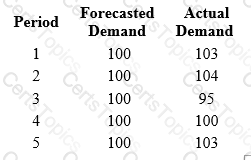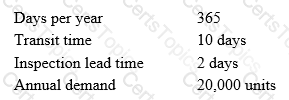Which of the following techniques deals with analysis and planning of logistics and manufacturing during various time periods?
Which of the following plans generally includes an organization's explicit mission, goals, and objectives, along with the specific actions needed to achieve those goals and objectives?
If the quantity ordered equals the quantity required in a time bucket, which of the following lot-sizing rules has been used?
Which of the following phrases best defines a production plan?
Which of the following processes converts the master production schedule into resource requirements that are then compared to the available resources?
Which of the following statements describes the difference between capacity requirements planning and material requirements planning ?
Which of the following forecasting techniques eliminates the need to keep months of historical data?
Which of the following describes a competitive characteristic that a firm must exhibit to be considered as a supplier in a market?
In Quality Function Deployment, "competitive evaluation" refers to:
The question below is based on the following information:

What is the mean absolute deviation of demand for the data?
An extreme change in demand in the supply position upstream generated by a small change in demand downstream in the supply chain is called the:
Which of the following items is a source of independent demand?
The ABC approach to inventory management is used primarily to:
The final purchasing steps in order completion are:
Which of the following statements best describes an example of advance ship notice?
To provide the required level of customer service, to minimize the costs of transportation and handling, and to interact with a factory to minimize scheduling problems are all objectives of:
Which of the following inventory classifications would include semi-finished goods at an outside supplier?
The question below is based on the following information:

What is the average annual transit inventory in units?
Which of the following production environment strategies requires unique design or significant customization?
Which of the following items is considered an external failure cost?
Which of the following types of layouts is most efficient in a lean production environment?
Which plant type describes a product at one stage that can be transformed into several distinct products at the next stage (divergent points)?
The question below is based on the following cost information:

What is the carrying cost?